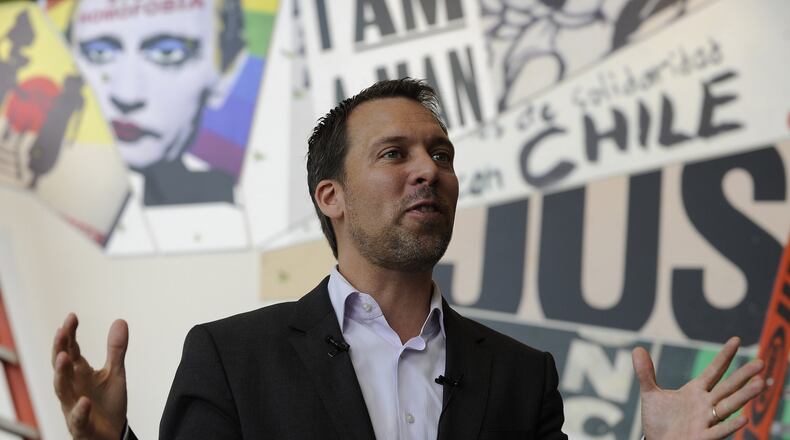The Woodruff Arts Center, the solar plexus of Atlanta’s creative world, will come under new leadership this summer when Doug Shipman takes over as the center’s president and CEO.
Shipman is known for nurturing the creation of the Center for Civil and Human Rights, and then serving as its founding CEO. More recently he served as CEO of BrightHouse, an Atlanta-based corporate consulting group founded by Joey Reiman.
Beginning on July 18 Shipman will replace Virginia Hepner, a long-time banking executive who has served as the leader at the Woodruff since 2012.
Shipman, 44, took some time recently to talk about his plans for the arts organization, which is the third-largest in the country.
Q. Has running the Woodruff been part of your master plan?
A. I really didn’t think about it until I was first approached as part of the search. I thought, gosh, there is so much momentum there, so much positive energy, so many things that are happening there, could I see myself there? And I answered, yeah, I could really see myself there.
Q. The Woodruff (with a budget of $90 million) is a lot bigger than the Center for Civil and Human Rights. What lessons will you take from the rights center to your new job?
A. Doing the center taught me a lot about how to run a cultural institution, and how to manage a whole community’s effort to lift itself up.
Q. Virginia Hepner has just finished a successful $112 million fund-drive. Does that mean you’re at cruising altitude?
A. I think this is now an organization on good footing. What do you with an organization that’s healthy and on good footing? You build on it… We’re not at cruising altitude, so much as accelerating toward liftoff. That takes work but … the work done over last five years has put this within reach.
Q. One of the things Virginia stressed was strengthening the Woodruff’s connection with its potential audience. How can you do that?
A. One: You have to have absolutely great content. The art has to be fabulous, that’s the first thing. Everything flows from that: Great exhibitions, great shows, great performances, etc. Two: You’ve got to have lots of creative ways to tell people about it. Different avenues, whether they’re looking on the phone or talking to friends or watching TV. You have to be flexible and savvy about the ways you’re telling them.
Q. How will you deal with attracting visitors from the suburbs to come to Midtown?
A. It’s not only a challenge and an opportunity to bring folks in from Gwinnett (and elsewhere). Look at the cranes in Midtown and downtown. Thousands of new people are moving in, and will be within two miles of here, with new towers going up on Spring Street, West Peachtree, Juniper. (We want to attract people from inside and outside the city limits.) It’s not either/or, but both/and.
Q. This will be the biggest organization you’ve run. What are the unique challenges of an entity this size?
A. One: You have to, as a leader, set a very clear vision and a clear set of principals to approach that vision, then be smart enough to let the great people who are doing the work actually do the work. Really strong leaders don’t do the work, that’s not their job. Two: You’ve got to have good reports, good clarity, good information that flows to you as a leader. Three: We have an enormous number of people who want to help. The leadership overall has to find ways you can catalyze people who want to help, not just through donations but with their time, their expertise, their willingness to dig into problems, to grow.
Q. BrightHouse offers almost a psychotherapy for corporations, helping them define themselves. Does the Woodruff need that?
A. It’s not psychotherapy. We try to help an organization understand its ethos, its purpose, its vision, its values, and then communicate those in a way that excites employees and excites consumers. (What we’ve found is) the fruit is in the roots. A lot of what is special about an organization is within its own legacy, its own history, its own structure … We’re coming up on the 50th anniversary of the Memorial Arts building next year. Its history is so rich, but sometimes organizations forget those rich stories. They have gold sitting around that they’re not using.
Q. The rights center is a politically active group. Will the Woodruff also be active politically?
A. The arts center needs to be relevant and needs to be causing conversations. The shows on stage at the Alliance absolutely cause conversations. After I attended ‘The Magic Negro’ show on the Hertz Stage, which was incredibly relevant and interesting, I was talking about it for days, with people who saw it and those who didn’t… In tumultuous political or societal times, artists are always the ones who help us make sense of those times. We can agree that there is a lot of tumult in our political and social world right now and we’re trying to figure out where we are and where we want to go.
Q. You and your wife Bijal Shah have two children under six and challenging careers. How do you manage that?
A. Bijal is a Grady emergency room doctor. She puts everything into perspective. I never win the ‘I-had-a-bad-day-at-the-office’ contest.
About the Author
Keep Reading
The Latest
Featured




